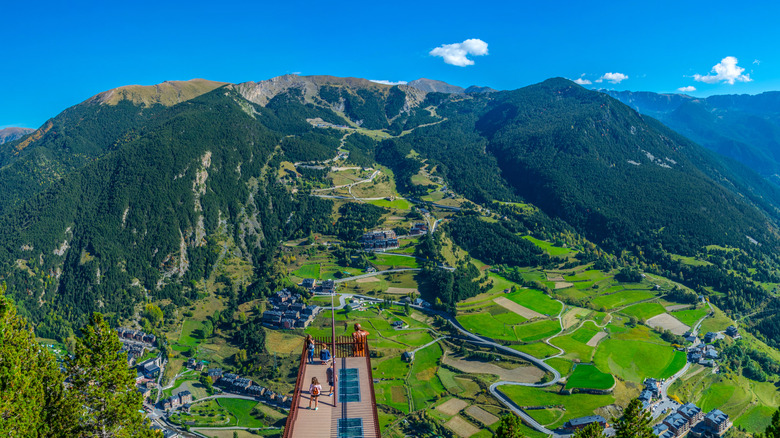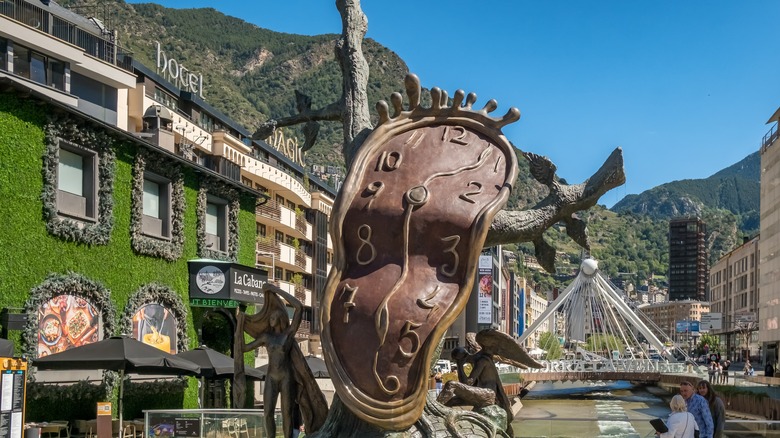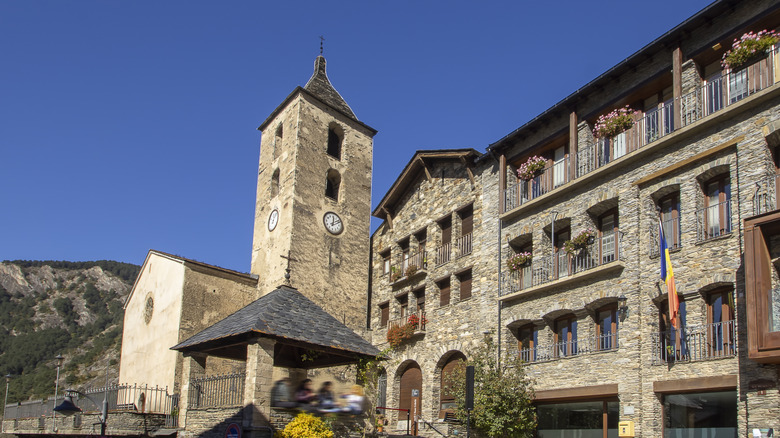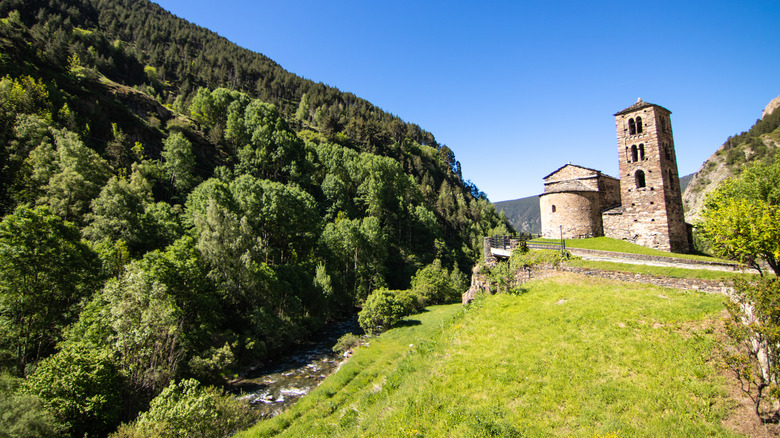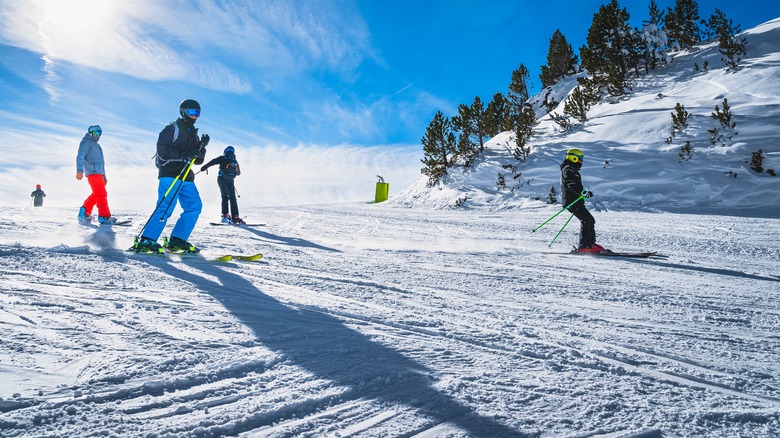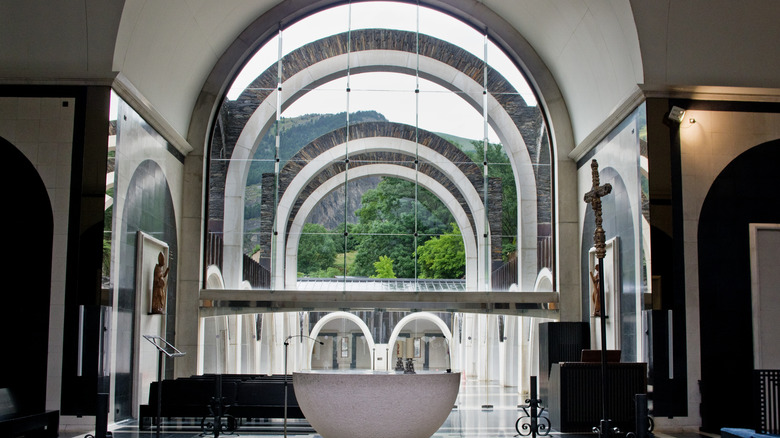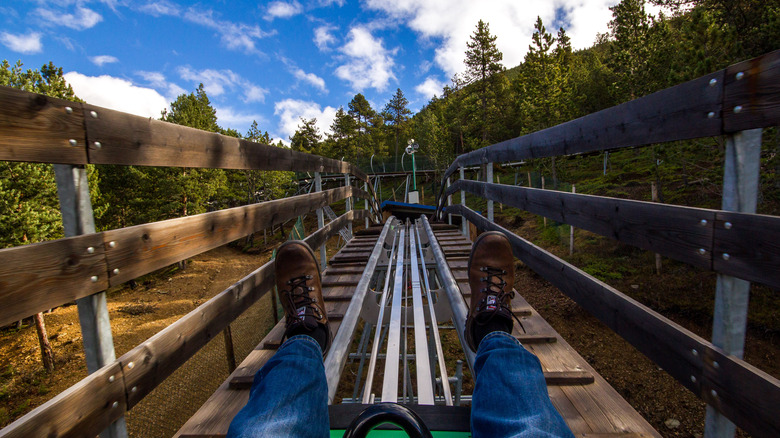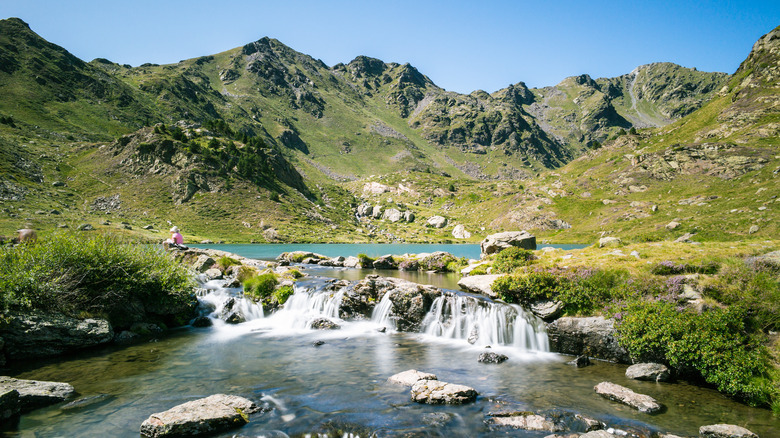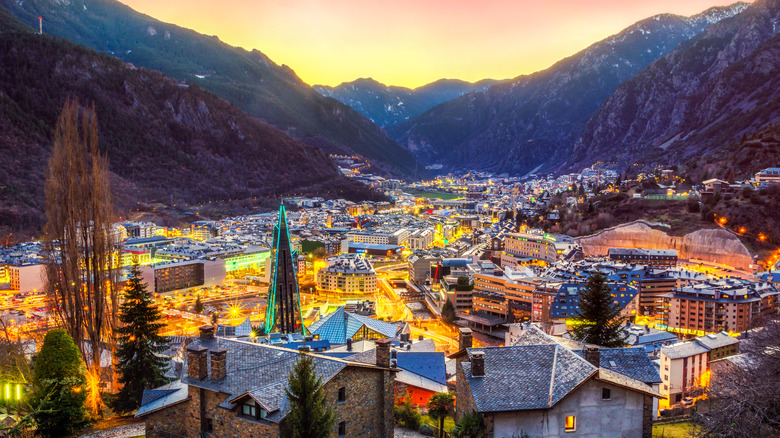Andorra's 12 Most Lovely Attractions And Sights Tourists Should Never Skip
Travel writer Rick Steves once blogged about Andorra: "I go there so you won't have to." He even considered its capital to have "the charm of a giant shopping mall." And, while Andorra does have a reputation for duty-free shopping, this tiny country, ensconced in the Pyrenees between France and Spain, is also slowly making a name for itself in other ways. Andorra's 13 loveliest tourist attractions include incredible outdoor recreation opportunities, historical monuments, famous artworks, intriguing museums, thermal baths, and ancient stone churches. In fact, Andorra is a mini-treasure trove — and it's quite budget-friendly, especially compared to its pricier neighbors. On later visits, Rick Steves himself noted that "times are changing" in Andorra and that it's possible to find "pockets of Old World charm" in this "year-round outdoor-sports destination."
Andorra covers just about 181 square miles, and most of this is mountainous terrain, with dramatic peaks and deep valleys, dotted with tiny stone villages. Besides shopping, Andorra is known for its skiing, the Pyrenees' best. However, the mountains are full of adventure outside of winter, with endless hiking trails, swinging bridges, Alpine slides, and even a mountainside sculpture park. Many Spanish and French locals flee the summer heat to the cooler climes of Andorra's three nature parks (not bad for a microstate!).
As Andorra doesn't have its own airport, most visitors fly into Toulouse, France (about four hours away) or Barcelona, Spain. At three to four hours away, Andorra is too far to be an ideal day trip from Barcelona, yet it's still within easy reach. Within Andorra, the public bus system is well-connected, although a car will allow you full freedom of movement. Luckily, you never have too far to travel in Andorra!
Casa de la Vall in Plaza del Consell
Andorra la Vella has the distinction of being Europe's highest capital city (and also one of its smallest). The graceful Old Town in Andorra's capital is a must for anyone visiting this tiny little country, and its highlight is the Casa de la Vall. A 16th-century manor home turned parliament building from 1702 until 2011, the Casa de la Vall, in the lovely Plaza del Consell, tells the story of Andorra's history.
Located in Andorra's historic district, Barri Antic, the stone facade of Casa de la Vall, giving off both fortress and mansion vibes, looks much as it must have in 1580. Inside, 30-minute guided tours (in English, French, and Catalan, the official language of Andorra) provide a quick but thorough overview of the most important rooms and the general history of Andorra and its parliament. Take a peek inside Andorra's only courtroom, the Tribunal de Corts, as well as the beautiful Sala del Consell, the former chambers of parliament, with just 28 seats (four from each of Andorra's seven parishes). Another room of note is the Sala de la Justicia, featuring the Cabinet of the Seven Keys (Armari de les Set Claus), where all of Andorra's important documents were once stored, which could only be opened by seven keys, one from each parish.
Mirador Roc Del Quer & Pont Tibeta
Andorra may get on your radar if you're hoping to achieve the extremely rare travel goal of visiting every country in the world (the microstates count too!), but the incredible views of the Pyrenees are worth a visit on their own. Some of the best mountain views in all of Andorra are from the Mirador (viewpoint) Roc Del Quer, a wooden and glass platform standing high in the mountains above the small Andorran towns of Canillo and Ordino in the Valira d'Orient valley. Stretching nearly 40 feet over the valley floor, some 6,500 feet below, the platform is designed to give viewers the experience that they're floating in mid-air. At the end of the platform is the unique bronze statue of "The Ponderer," gazing out over the landscape.
For even more insane views, head to the jaw-dropping Pont Tibeta (Tibetan Bridge). One of the longest pedestrian bridges in the world, at 1,978 feet long, you can buy a ticket to walk the full expanse, or the extra intrepid travelers can even bungee jump off the side of the Pont Tibeta. Combination tickets to visit both the bridge and the viewpoint can be purchased; with the ticket, a bus ride to both attractions is included.
Madriu-Perafita-Claror Natural Park
Those hoping to avoid crowds at a lesser-known European destination should head to Andorra, and within Andorra, to the glacial landscape of Madriu-Perafita-Claror Natural Park, deep in the Pyrenees. The Vall del Madriu-Perafita-Claror is only about 16 square miles, yet it covers a full 9% of the country. Its incredible natural beauty and ancient medieval huts, known as bordas, stone refuges still in use by local shepherds, combine to make it Andorra's only destination on the UNESCO Heritage list. It also features some of Europe's rarest endangered species, like the Pyrenean chamois, a mountain goat-antelope.
The Vall del Madriu-Perafita-Claror is notable in that the land is under the stewardship of local communities and has been for generations. In addition to the remnants of the now-gone Catalan Forge industry, there are no roads in the valley save a cobbled path, for pedestrians only. To explore the picturesque lakes, green meadows, and expansive forests, take this path or one of the other footpaths, and spend the night in one of the old bordas, which you'll need to book ahead of time.
La Noblesse du Temps (The Nobility of Time)
One of Andorra's claims to fame lies in the middle of Andorra la Vella: La Noblesse du Temps, or the Nobility of Time, a bronze sculpture by famed artist Salvador Dalí, icon of the surrealist movement. Dalí was born in northern Spain, part of the Catalonia region, of which Andorra is also part, giving him deep ties to the country. Like many of Dalí's most famous works, the key figure in the Nobility of Time is a melting clock or a soft clock, said to symbolize the seemingly flexible passage of time.
The 16-foot high sculpture is in Andorra la Vella's Plaça de la Rotonda, and features the clock hanging from the branches of a tree, growing out of brick, along with a contemplative angel and a woman with a shawl. Various understandings of the work have been theorized, and as was characteristic of much of Dalí's works, more intriguing details emerge the longer you examine the sculpture. Dalí intentionally left it open for interpretation, as his goal in his art was self-stated: "What matters is to sow confusion, not eliminate it" (via Guiand Andorra).
Ordino Museums
The tiny town of Ordino, just about 15 minutes outside of Andorra's capital, feels like a museum itself, with its ancient stone buildings and picturesque setting. Within this small town, however, you'll find several unique museums. One of these is the Museum of Miniatures (Museu de la Miniatura), featuring the smallest pieces of art on the planet — so small you'll need to look through a microscope to even see the "microminiature" masterpieces, all by the Ukrainian artist Nikolai Syadristy, considered the best miniature artist in the world. Through the microscope, you'll see a rendering of camels inside the eye of a needle, crosses on grains of rice, his signature on a single hair.
Another Ordino museum was once a noble home, now restored with the original furniture, artwork, and decor. The Casa d'Areny-Plandolit, dating back to the 12th century, is the only original manor home in the country that has remained relatively unchanged. Once home to the prominent Andorran Don Guillem d'Areny-Plandolit, Baron of Senaller i Gramenet, along with his family, the beautifully preserved mansion reflects a bygone era in Andorra in its luxurious interior and lovely gardens.
Caldea Spa in Les Escaldes
In the Escaldes-Engordany parish, the district of Les Escaldes is home to Andorra's thermal waters. The best place to experience these therapeutic pools is at the stunning Caldea Spa, with indoor and outdoor lagoons. This is Andorra's tallest building, and the glass shards can be seen for miles away. Built on top of natural hot springs, the Caldea Spa is one of the largest spas in Europe, with dozens of themed pools, along with adult-only or child-friendly sections. Soak outside with stellar mountain views, swim in dark cave pools, dip into an ice bath, try out the Turkish hammam, or get a variety of treatments, like a massage. There are pools dedicated to aqua massage, pools filled with grapefruit for a natural exfoliation experience, multi-level pools with waterfalls, and so much more.
There are a variety of different passes, at various price points, to access Caldea Spa, starting at $30 for the "Classic" ticket, which includes indoor and outdoor lagoons, along with the glass-bottomed panoramic lagoon, which hovers over the river. The main lagoon is open until midnight, and thanks to the glass ceilings, it has excellent mountain, sunset, and starlight views. For kids ages 3-8, there's even a kids-only area, where parents drop off the kids (under the supervision of Caldea staff) to partake in their own "spa" activities, while the adults go get pampered elsewhere.
Church of Sant Joan de Caselles
Andorra has several notable churches, and perhaps the most beautiful is also one of its oldest: the Church of Sant Joan de Caselles (Església de Sant Joan de Caselles) in the small hamlet of Canillo. The oldest part of the San Joan de Caselles, the temple, dates to the mid-11th century. Its distinctive Lombard bell tower, characteristic of Andorran churches from this age, still stands stalwart in the mountainous landscape, along with the rest of the church, perched upon a rock above the camí ral (old road) that traditionally connected Canillo with destinations in France. Various other architectural features were added throughout the years, like a 15th-century porch and a 16th-century altar.
Along with the altar, the walls are decorated with colorful murals from the Bible, primarily concerning the life of Saint John, the patron saint of the church. While it's free to access the church, it's only open to visitors during July and August. However, the exterior is always there for exploration, photography, and as a jumping-off point to explore charming Canillo. Just eight minutes down the road (on foot) is the beautiful Cascada de Los Moles, a 115-foot-high waterfall cascading down a rocky mountainside.
Andorra's famous ski resorts
Many people visit Andorra for its unparalleled access to Pyrenees skiing. There are several for your choosing, covering nearly 200 miles of pristine slopes. The largest ski resort in Andorra (and in fact, the largest in the Pyrenees and one of the largest in the world) is the epic Grandvalira. Within Grandvalira alone, there are over 130 miles of skiing access, covering seven unique sections, including the upscale Soldeu and the fun El Tarter, known for its aprés-ski at the famous L'Abarset, a restaurant-bar in an idyllic (and large) mountain chalet.
Grandvalira also has the option of buying a single pass, the Andorra Pass, that gets you access to three different iconic ski resorts. You'll then have free rein on the slopes of Grandvalira (of course), along with Ordino Arcalís and Pal Arinsal (under one umbrella as Vallnord). Pal Arsinal is especially family- and beginner-friendly, with a snow garden and plenty of green and blue runs. If you prefer to go off-piste, there are plenty of backcountry opportunities, often connecting to the various resorts. Download the Grandvalira app for a map of all of the trails, both on- and off-piste, within the resort.
Outside of the Andorra Pass, there are a variety of passes at various price points, from half-day passes to season passes and everything in between. The passes are highly customizable, enabling skiiers to tailor them to the length of their trip, their ability. There's even a pass for those who don't want to ski but want access to the resort for other activities like snowshoeing, ice skating, dog sledding, snowmobiling, and more.
Basilica Sanctuary of Meritxell
Andorra's patron saint is Our Lady of Meritxell, but unfortunately, the historic church dedicated to said saint burned down in the 1970s. The new, modern cathedral, designed to honor the former cathedral while tying it to the future, is one of the most intriguing religious monuments in Europe. While the village, Meritxell, is only about 75 people strong, it's famous throughout the country as the home to Andorra's patron saint, Our Lady of Meritxell, and therefore is considered the spiritual center of the country. According to legend, villagers in Meritxell discovered a wooden statue of the Virgin Mary residing under a blooming winter rose bush. After several attempts to move the statue to different places of worship, it kept mysteriously returning to its original rosebush. And so the villagers built a new church to house the statue, which stood for 800 years until a devastating fire in 1972, which destroyed the entire church, including the statue sheltered within. Unfortunately, the replacement statue was stolen and again burned in 2005. The current iteration resembles the original as closely as possible, going off photographs and descriptions.
Rather than just rebuilding the original church to house the new statue, Catalan architect Ricardo Bofill designed a dramatic, modern, spare building, with exposed white and black arches, along with remaining sectors of slate and stone from the prior church incorporated into the new design. The current Sanctuary of Meritxell Basilica, Basilica of Nuestra Señora de Meritxell, attracts thousands of Andorrans each year on September 8, the feast day of Our Lady of Meritxell. The town itself comes alive with festivities dedicated to Meritxell, with Catholic ceremonies, local cuisine, and traditional Catalan dances with music.
Tobotronc at Naturlandia
Naturland, a fun adventure center in the mountains near Sant Julià de Lòria, also happens to feature the world's longest Alpine slide: the Tobotronc. Naturland itself is worth a visit, especially for nature and adrenaline lovers, as a nature-themed amusement park and zoo. See endemic wild animals like wolves, bears, and ibex, learn archery, or put your child on a pony. Older kids and adults will enjoy obstacle courses, ropes courses, and giant jumping platforms, as well as the famous Tobotronc.
The longest Alpine slide (or toboggan run) in the world, the Tobotronc cruises through the gorgeous Pyrenees forest for 3.3 miles, dropping 1,312 feet along the way during its 10-minute run. Riders can choose their own speed thanks to a manual brake installed in each car (if you ride said brake, it may take a bit longer than 10 minutes). For an even more thrilling and picturesque experience, ride the Tobotronc during dusk to immerse yourself in the enchanted landscape.
Juberri Gardens
Near Naturland in Sant Julià de Lòria are the vast Contemporary Gardens of Juberri (Los Jardines Contemporáneos de Juberri), part nature oasis, part contemporary art exhibit. This sloping garden was designed by Andorran resident Nicole Grignon, who collected a variety of sculptures and began placing them around a gorgeously designed garden, high on a mountain, deep in the forest. Standing at 4,265 feet above sea level, the Juberri Gardens overlook some of the best views of the Pyrenees in Andorra — an extra dramatic and scenic bonus of this mystical, enchanted garden.
As you wander through the forest gardens, keep an eye out for notable sculptures like a beautiful bronze bear, a camel, a dragon, and fighting dinosaurs. The gardens are loosely divided into three themed sections: zoo animals, local wildlife, and sculptures exclusively designed by Andorran artist Ángel Calvente. However, there are plenty of sculptures that don't quite fit into these categories (like the dragon). Note: The Juberri Gardens are open year-round, 24 hours a day (no camping!), and while the paths are relatively flat, the terrain is uneven, so bring good shoes, especially if you visit during the winter months.
Tristiania Lakes in El Serrat
It's not surprising that mountainous Andorra, the perfect destination for avid skiers, is also a haven for hikers. One of the best trails, in the beautiful village of El Serrat, is the Tristiania Lakes trail (Estanys de Tristaina), a trio of picture-perfect mountain lakes reached by a moderate trail. Near both El Serrat and Ordino, a UNESCO Biosphere Reserve, the full Tristaina Lakes trail is a 2.7-mile loop, although it can be split into sections. The first lake, Estany Primer, can be reached in under 40 minutes from the main parking lot (Coma), and is especially child- and family-friendly. Stop at the first (and bluest) lake, or continue to the middle lake, Estany del Mig, and the final (and biggest) lake, Estany de Més Amut (the Above Lake), which sits at 7,644 feet above sea level. As you meander through the high-altitude glacial landscape, keep an eye out for wild Percheron horses or stoat, a small weasel-type animal.
The full loop takes approximately three hours and requires a moderate degree of fitness and decent shoes. The weather can also be changeable, even in the summer, so do your research (grab a map at the Andorran Tourist Office, or download the official Active Tourism Andorra app for updates). For the best weather and trail conditions, hike in the summer months, between June and September. The height of summer is also when it's permissible to swim in the lakes, particularly enjoyable and practically essential after such a hike.
Methodology
For this article, we sourced data from local Andorran tourism sites, like Guiand Andorra, travel blogs, and travel experts, like Rick Steves, to narrow down the list of Andorra's loveliest sights. We also used Tripadvisor and other review sites to discover which attractions in Andorra are the most popular. For select attractions, we checked our facts directly on their website to ensure we're sharing up-to-date information. In addition, we endeavoured to include a diverse mix of things to see (or do) in Andorra, from churches to museums, skiing to hiking, art to spas, to really showcase the diversity that this tiny country offers.


